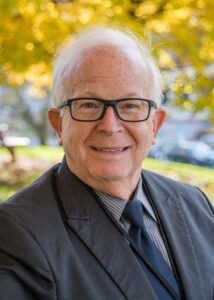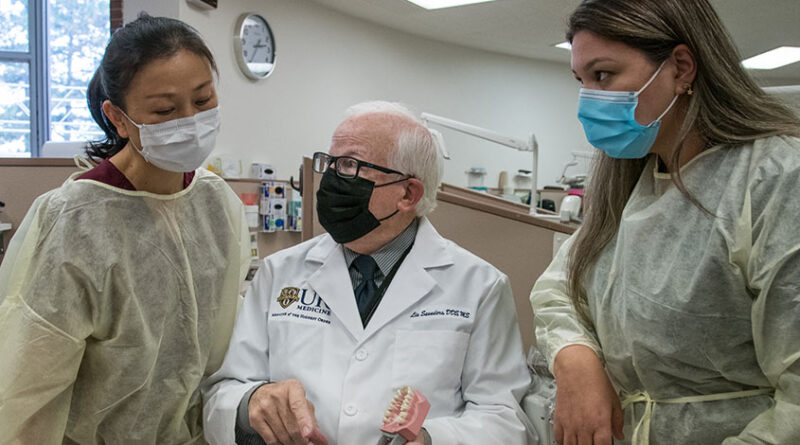Shaping the Future of Elder Dentistry Care
After 45 years at it, Ralph Saunders has no intention of slowing down any time soon
By John Addyman
Ralph Saunders is a busy guy. Three or four days a week you’ll find him in the Schottland YMCA in Pittsford, working the elliptical machine, rowing machine, weight training and aerobics.
He loves to read and enjoys jazz and classical music.
He recently took up pickleball.
He’s competed in the YMCA Tri-Y, a mini-version of a triathlon.
“I haven’t placed first in my age group, but I’m hoping to live long enough that the other guys will have a tougher time than me. I play the trumpet, too,” he said. “I like to keep my embouchure doing well. I’ve played in groups, in jazz concerts.”
At work, he spends 30% of his time teaching, 30% in program development and research, and 40% working on his craft.
Saunders, 75, is a professor of dentistry and medicine — geriatric medicine at the Eastman Institute for Oral Health at the University of Rochester, where he was the director of the geriatric dentistry training program until this year.
The men and woman in his classes, dental students with their DDS degrees, have come to Eastman for higher-level classes. When he started teaching 45 years ago, he could expect about 12-15 students taking his course in geriatric dentistry. Now there are 40-45 filling the lecture hall.
Why?
“Older people have the greatest oral health needs,” he said. “They are in the age group that has experienced the most loss of teeth, the most cavities that form in the roots of teeth and are very hard to fix, they have the greatest periodontal health concerns, the most oral lesions [sores in the mouth] and they make the fewest number of dental visits due to medical, transportation, social or mental health issues.”
That’s the bad news for folks whose mouths are of a certain age.
Saunders said there’s a lot of good news.
“Dentistry, especially, to me, was a personal and direct way that I could contribute to the welfare of patients I would see,” he said. “When dentistry is talked about and discussed, nearly always the issue of pain comes up. We don’t have very good PR in that regard. We don’t care for that. We wish it wasn’t that way. We try to help with it. We also know that in a number of cases where there is pain, we can help relieve it. To help with that is really very rewarding.”
“I’ve enjoyed so much, and am privileged really, to get a chance to enhance people’s quality of life. If people have lost some of their teeth, they don’t like that situation. We can replace those teeth better today than we ever have before. It makes eating easier and especially for older adults, especially for some who are frail, eating and enjoying what you’re eating may be one of the few things to really to look forward to and we can often help with that,” he continued.
When older people can eat better and choose their foods without regard to how chewy it is, that’s considered a quality of life issue, he noted.
“Dietitians want us to choose different kinds of food including those that are chewy, like fruits, vegetables and meat. Having all the teeth is commonly a social benefit. At the start of my dentistry work in 1977, I was the primary dentist at Monroe Community Hospital, here in Rochester. It’s a 600-bed chronic care hospital affiliated with UofR which is like a large, concentrated nursing home. People are encouraged to sit in a large cafeteria with at tables other people, and they like it best if they don’t have funny-looking teeth or spaces between their teeth. We can usually help with those kinds of situations,” he said.
He was born in small-town Stanford, Kentucky, to a father who was a pastor and a mom who taught in public school.

Four months after he was born, young Ralph’s family moved when dad was called to a church in Greencastle, Indiana. When he was 8, Saunders moved again to a new church in New Albany, Indiana. His next stop after that was DePauw University, and he graduated from there in 1968 and took his first job as a biology teacher in the Green Hills/Forest Park schools in Ohio.
“I wasn’t focused on dentistry yet: I wanted to teach,” Saunders said.
He stuck with it for three years, and then went to dental school at Ohio State.
“Early on in college I asked myself, ‘What should I be?’ I knew I would be working hard and studying and taking a lot of courses that I thought could be helpful in the future, especially science courses,” he said. “And I kept asking myself, ‘How can I be of good service to others?’ Being a dentist came to mind. Both my parents were giving-type people who had a good amount of empathy for people who were in difficulty or who had needs. They were compassionate and caring. Those attributes have been beneficial to me.”
“I was very pleased and I felt a little funny about it in my dental career, if a patient would say to me, ‘For some reason, I feel comfortable with you.’ Perhaps it’s because I have a generally softer voice, that may be a benefit,” he added. “Anyway, they felt like I was compassionate and I’m sure my parents had a part in that.”
Another factor is Saunders’ professorial approach to things. He looks and acts the part of someone who has a lot of knowledge, common sense and genuinely wants to help.
He made another career move after getting his DDS at Ohio State, he went for the advanced training program at the University of Rochester, with two years of internship and a dental residency.
When he was getting ready to leave for Rochester, his friends back in New Albany (which is across the river from Louisville) sent him off with a piece of advice: “When you start the program in July, you’ll need your snow shovel to move in.”
He found a home and a practice within the UofR Eastman network.
“I was very fortunate. I got to stay on the faculty,” he said.
At Eastman Institute for Oral Health, classwork begins at 8 a.m. and students are in clinic at 9. An increasing number of patients are older. And because of COVID-19 restrictions right now, fewer.
“We are unable to accommodate all patients who may request our service in a timely manner just now,” he said. “Older adults as well as others who may call for appointments need to expect to wait up to several weeks.”
Saunders and his teaching colleagues work in teams of three overseeing what 16 residents under their tutelage will be seeing in their chairs each day.
“When one of our residents has someone in the chair and I or another member of the faculty sees something that could be of benefit working with the patient and showing the trainee how to do it, we could stand right beside them with our mask and glove and gown and look right into the mouth to see what’s happening. We sit as close as a dental assistant,” he said. “But, we wouldn’t typically just sit there if the resident or trainee feels he or she is doing well. But we could if we’re needed.”
He directed three funded fellowship programs that trained geriatric dentists.
“The students who have an interest in geriatrics and follow that through and work hard at being good dental geriatricians, those are people, students, residents who have a good level of compassion for others. They’re not just doing their jobs, they’re doing something they love that is beneficial to their patients and they want to contribute to that,” he said.
Saunders’ class in geriatric dentistry is a requirement in the program.
“I’ve enjoyed teaching so much and I hope it’s the case that people enjoy the class,” he said.
Is he thinking about retirement?
“If I choose to and my health remains good, I can practice dentistry as long as I want. The university doesn’t have a cut-off time of age 74 or 75 for dentists. As long as you can do the job and help people, you can continue,” he said. “I very much enjoy that perspective as I continue on my career.”
He doesn’t lead a dull life and is certainly in a lot of social circles. But he never married.
“I’m open to the idea,” he said sincerely.
At the 55th reunion of his graduating class, he was introduced as the gentleman at the table who was not married.
“Not married yet,” he told them.
You give your life to a career you love and it’s hard to imagine something else replacing it.
Saunders is a gentle, caring man with small-town neighborly values who has spent a lifetime teaching others to help those who need it most. It makes you wonder how far his unselfish heart reaches to others through a generation of students.
Featured Image: Ralph Saunder teaches one of his classes at the Eastman Institute for Oral Health. When he started teaching 45 years ago, he could expect about 12-15 students taking his course in geriatric dentistry. Now there are 40-45 filling the lecture hall.

